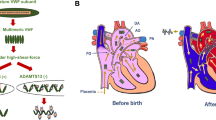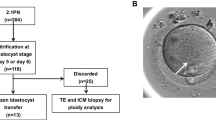Abstract
While mitotic errors commonly cause aneuploid clones soon after conception, the embryos often normalize as clones are rapidly eliminated. Although generally considered benign, evidence suggests clone elimination as the primary cause of the vertebral, ano-rectal, cardiac, tracheo-esophageal, renal, and limb (VACTERL) association of anomalies, and possibly other adverse outcomes as well. Here, clone elimination-related development disruption at specific locations is used as the basis of a comprehensive theoretical VACTERL association model that also elucidates mitotic mosaic aneuploidy effects. For the association, the model explains random temporal and spatial origins during a limited time frame and overlapping clusters of component anomalies. It supports early developmental effects involving the stage of determination, where the position in a specific morphogen field controls what a cell will become and where it will be located. Developmental properties related to determination also create specific vulnerabilities to the midline and distal defects, the latter explaining exclusively radial and tibial defects with duplications and deficiencies. The model also supports isolated anomalies as part of the association and, for mosaic mitotic aneuploidy, indicates that clone elimination nears completion at the time of lower limb determination. Although mosaic clone elimination may cause other defects, occurrences in different developmental fields separate them from VACTERL anomalies. Clone elimination may also be related to risks for a single umbilical artery and for non-structural adverse pregnancy outcomes such as losses, prematurity, and growth delays, while a paucity of clone lethality in non-humans explains the rarity of the association and of single umbilical arteries in animals.
Similar content being viewed by others
References
Munné S, Wells D. Detection of mosaicism at blastocyst stage with the use of high-resolution next-generation sequencing. Fertil Steril. 2017;107:1085–91.
McCoy RC. Mosaicism in preimplantation human embryos: when chromosomal abnormalities are the norm. Trends Genet. 2017;33:449–63.
Solomon BD. VACTERL/VATER association. Orphanet J Rare Dis. 2011;6:56. https://doi.org/10.1186/1750-1172-6-56.
Daughtry BL, Rosenkrantz JL, Lazar NH, Fei SS, Redmayne N, Torkenczy KA, et al. Chromosome removal via cellular fragmentation and aneuploid blastomere exclusion in primate embryos. bioRxiv. 2018;1:241851.
Rittler M, López-Camelo JS, Castilla EE, Bermejo E, Cocchi G, Correa A, et al. Preferential associations between oral clefts and other major congenital anomalies. Cleft Palate Craniofac J. 2008;45:525–32.
Rittler M, Paz JE, Castilla EE. VACTERL association, epidemiologic definition and delineation. Am J Med Genet. 1996;63:529–36.
Botto LD, Khoury MJ, Mastroiacovo P, Castilla EE, Moore CA, Skjaerven R, et al. The spectrum of congenital anomalies of the VATER association: an international study. Am J Med Genet A. 1997;71:8–15.
Opitz JM. Blastogenesis and the “primary field” in human development. Birth Defects Orig Artic Ser. 1993;29(1):3–37.
Martínez-Frías ML, Frias JL. Are blastogenetic anomalies sporadic? Am J Med Genet A. 1997;68:381–5.
Bryant SV, Gardiner DM. The relationship between growth and pattern formation. Regeneration. 2016;3:103–22.
De Robertis EM. Spemann’s organizer and self-regulation in amphibian embryos. Nat Rev Mol Cell Biol. 2006;7:296–302.
Källén K, Mastroiacovo P, Castilla EE, Robert E, Källén B. VATER non-random association of congenital malformations: study based on data from four malformation registers. Am J Med Genet A. 2001;101:26–32.
Solomon BD, Pineda-Alvarez DE, Raam MS, Bous SM, Keaton AA, Vélez JI, et al. Analysis of component findings in 79 patients diagnosed with VACTERL association. Am J Med Genet A. 2010;152:2236–44.
Cunningham BK, Khromykh A, Martinez AF, Carney T, Hadley DW, Solomon BD. Analysis of renal anomalies in VACTERL association. Birth Defects Res A. 2014;100:801–5.
Evans JA. Numerical taxonomy in the study of birth defects. Adv Study Birth Defects. 1982;5:139–60.
Carli D, Garagnani L, Lando M, Fairplay T, Bernasconi S, Landi A, et al. VACTERL (vertebral defects, anal atresia, tracheoesophageal fistula with esophageal atresia, cardiac defects, renal and limb anomalies) association: disease spectrum in 25 patients ascertained for their upper limb involvement. J Pediatr. 2014;164:458–62.
Evans JA, Vitez M, Czeizel A. Patterns of acrorenal malformation associations. Am J Med Genet A. 1992;44:413–9.
Khoury MJ, Cordero JF, Mulinare J, Opitz JM. Selected midline defect associations: a population study. Pediatrics. 1989;84:266–72.
Lubinsky M. Current concepts: VATER and other associations: historical perspectives and modern interpretations. Am J Med Genet A. 1986;25(S2):9–16.
Lubinsky M, Moeschler J. Different clusters within the VATER association distinguished through cardiac defects: possible effects of teratologic timing. Dysmorphol Clin Gen. 1987;1:80–2.
Stevenson RE, Hunter AG. Considering the embryopathogenesis of VACTERL association. Mol Syndromol. 2013;4:7–15.
Quan L, Smith DW. The VATER association: vertebral defects, anal atresia, tracheoesophageal fistula with esophageal atresia, radial dysplasia. Birth Defects Orig Art Ser. 1972;8:75–8.
Lubinsky M. The VACTERL association as a disturbance of cell fate determination. Am J Med Genet A. 2015;167:2582–8.
Lubinsky M. Blastogenetic associations: general considerations. Am J Med Genet A. 2015;167:2589–93.
Opitz JM, Gilbert EF. CNS anomalies and the midline as a “developmental field”. Am J Med Genet A. 1982;12:443–55.
Lubinsky M. Midline developmental “weakness” as a consequence of determinative field properties. Am J Med Genet A. 1987;28(S3):23–8.
Al-Harbi A, Winyard P. Anatomy, applied embryology, and pathogenesis of congenital anomalies of the kidney and urinary tract. In: Barakat A, Rushton H, editors. Congenital anomalies of the kidney and urinary tract. Cham: Springer; 2016. p. 15–27.
Lubinsky M. Explaining certain human limb anomalies and the radial ray-hematopoetic community of syndromes using a model of determination. Teratology. 1991;16:295–9.
Castori M, Rinaldi R, Cappellacci S, Grammatico P. Tibial developmental field defect is the most common lower limb malformation pattern in VACTERL association. Am J Med Genet. 2008;146A:1259–66.
Idkowiak J, Weisheit G, Plitzner J, Viebahn C. Hypoblast controls mesoderm generation and axial patterning in the gastrulating rabbit embryo. Dev Genes Evol. 2004;214:591–605.
Rallu M, Corbin JG, Fishell G. Parsing the prosencephalon. Nat Rev Neurosci. 2002;3:943–51.
Lemire RJ, Beckwith JB, Warkany J. Anencephaly. New York: Raven Press; 1978.
Molloy AM, Pangilinan F, Brody LC. Genetic risk factors for folate-responsive neural tube defects. Ann Rev Nutr. 2017;37:269–91.
Beaty TH, Marazita ML, Leslie EJ. Genetic factors influencing risk to orofacial clefts: Today’s challenges and tomorrow’s opportunities. F1000Res. 2016;5:2800.
Czeizel A. SCHISIS-association. Am J Med Genet. 1981;10:25–35.
Lubinsky M. An epigenetic association of malformations, adverse reproductive outcomes, and fetal origins hypothesis related effects. J Assist Reprod Genet. 2018;9:1–12.
Lubinsky M. Embryonic hypocellularity, blastogenetic malformations, and fetal growth restriction. Am J Med Genet A. 2017;173:151–6.
Dubourg C, Bendavid C, Pasquier L, Henry C, Odent S, David V. Holoprosencephaly. Orphanet J Rare Dis. 2007;2(1):8.
Moura E, Cirio SM, Villanova JA Jr. VACTERL association in a cat. Am J Med Genet A. 2010;152:777–80.
Lubinsky M. Evolutionary justifications for human reproductive limitations. J Assist Reprod Genet. 2018;35:2133–9.
Stein FJ, Martin JE. Single umbilical artery and other congenital defects in a calf. Anat Anz. 1985;159:369–72.
Miquel-Verges F, Mosley BS, Block AS, Hobbs CA. A Spectrum Project: preterm birth and small-for-gestational age among infants with birth defects. J Perinatol. 2015;35:198–203.
Brosens E, Eussen HJ, van Bever Y, Van Der Helm RM, Ijsselstijn H, Zaveri HP, et al. VACTERL association etiology: the impact of de novo and rare copy number variations. Mol Syndromol. 2013;4:20–6.
Lubinsky M. Sonic hedgehog, VACTERL, and Fanconi anemia: pathogenetic connections and therapeutic implications. Am J Med Genet A. 2015;167:2594–8.
Hilger AC, Halbritter J, Pennimpede T, Ven A, Sarma G, Braun DA, et al. Targeted resequencing of 29 candidate genes and mouse expression studies implicate ZIC3 and FOXF1 in human VATER/VACTERL association. Hum Mutat. 2015;36:1150–4.
Acknowledgments
I wish to thank Dr. Stephanie Bishop of the South University School of Pharmacy for her time, effort, and thoughtfulness in reviewing the ms., which improved it immensely.
Author information
Authors and Affiliations
Ethics declarations
Conflict of interest
The author declares that there are no conflicts of interest.
Additional information
Publisher’s note
Springer Nature remains neutral with regard to jurisdictional claims in published maps and institutional affiliations.
Rights and permissions
About this article
Cite this article
Lubinsky, M. The VACTERL association: mosaic mitotic aneuploidy as a cause and a model. J Assist Reprod Genet 36, 1549–1554 (2019). https://doi.org/10.1007/s10815-019-01485-y
Received:
Accepted:
Published:
Issue Date:
DOI: https://doi.org/10.1007/s10815-019-01485-y




